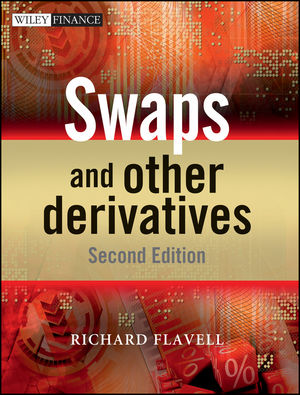Swaps and Other Derivatives, 2nd EditionISBN: 978-0-470-72191-9
Hardcover
392 pages
January 2010
 This is a Print-on-Demand title. It will be printed specifically to fill your order. Please allow an additional 10-15 days delivery time. The book is not returnable.
|
||||||
List of Worksheets (see the accompanying CD).
List of Abbreviations.
1 Swaps and Other Derivatives.
1.1 Introduction.
1.2 Applications of swaps.
1.3 An overview of the swap market.
1.4 The evolution of the swap market.
1.5 Conclusion.
2 Short-term Interest Rate Swaps.
Objective.
2.1 Discounting, the time value of money and other matters.
2.2 Forward rate agreements (FRAs) and interest rate futures.
2.3 Short-term swaps.
2.4 Convexity bias in futures.
2.5 Forward valuing a swap.
3 Generic Interest Rate Swaps.
Objective.
3.1 Generic interest rate swaps.
3.2 Pricing through comparative advantage.
3.3 The relative pricing of generic IRSs.
3.4 The relationship between the bond and swap markets.
3.5 Implying a discount function.
3.6 Building a blended curve.
4 The Pricing and Valuation of Non-generic Swaps.
Objective.
4.1 The pricing of simple non-generic swaps: forward starts.
4.2 Rollercoasters.
4.3 Pricing of simple non-generic swaps: a more complex example.
4.4 Forward valuing as an alternative to discounting-revisited.
4.5 Swap valuation.
5 Asset Packaging.
Objective.
5.1 Creation and pricing of a par asset swap.
5.2 Creation and pricing of a par maturity asset swap.
5.3 Discounting, embedded loans and forward valuing.
5.4 Further extensions to asset packaging.
6 Credit Derivatives.
Background and objective.
6.1Total return swaps.
6.2 Credit default swaps.
6.3 Pricing and hedging of generic CDSs.
6.4 Modelling a CDS.
6.5 Pricing and valuing non-generic CDSs.
6.6 Basket and portfolio CDSs.
6.7 Credit exposure under swaps.
6.8 Appendix: An outline of the credit modelling of portfolios.
7 More Complex Swaps.
Objective.
7.1 Simple mismatch swaps.
7.2 Average rate swaps.
7.3 Compound swaps.
7.4 Yield curve swaps.
7.5 Convexity effects of swaps.
7.6 Appendix: Measuring the convexity effect.
7.6.1 Two approaches to measuring the convexity effect.
7.6.2 A general mismatch swap.
7.6.3 Yield curve swaps.
8 Cross-market and Other Market Swaps.
Objective.
8.1 Overnight indexed swaps.
8.2 Cross-market basis swaps.
8.3 Equity and commodity swaps.
8.3.1Commodity swaps.
8.4 Longevity swaps.
8.5 Inflation swaps.
8.6 Volatility swaps.
9 Cross-currency Swaps.
Objective.
9.1 Floating-floating cross-currency swaps.
9.2 Pricing and hedging of CCBSs.
9.3 CCBSs and discounting.
9.4 Fixed-floating cross-currency swaps.
9.5 Floating-floating swaps continued.
9.6 Fixed-fixed cross-currency swaps.
9.7 Cross-currency swap valuation.
9.8 Dual-currency swaps.
9.9 Cross-currency equity swaps.
9.10 Conclusion.
9.11 Appendix: Quanto adjustments.
10 OTC Options.
Objective.
10.1 Introduction.
10.2 The Black option-pricing model.
10.3 Interest rate volatility.
10.4 Par and forward volatilities.
10.5 Caps, floors and collars.
10.6 Digital options.
10.7 Embedded structures.
10.8 Swaptions.
10.9 Structures with embedded swaptions.
10.10 Options on credit default swaps.
10.11 FX options.
10.12 Hedging FX options.
10.13 Appendix: The SABR model for stochastic volatility.
11 Swapping Structured Products.
Objective.
11.1 Introduction.
11.2 Examples of some structured securities.
11.3 Numerical interest rate models.
11.4 Simulation models.
11.5 Appendix: Extensions to numerical trees.
11.5.1 Incorporating a volatility smile.
11.5.2 Hull-White numerical trees.
11.5.3 Extensions to BDT and HW models.
12 Traditional Market Risk Management.
Objective.
12.1 Introduction.
12.2 Interest rate risk management.
12.3 Gridpoint risk management-market rates.
12.4 Equivalent portfolios.
12.5 Gridpoint risk management-forward rates
12.6 Gridpoint risk management-zero-coupon rates.
12.7 Yield curve risk management.
12.8 Bond and swap futures.
12.9 Theta risk.
12.10 Risk management of IR option portfolios.
12.11 Hedging of inflation swaps.
12.12 Appendix: Analysis of swap curves.
13 Value-at-Risk.
Objective.
13.1 Introduction.
13.2 A very simple example.
13.3 A very simple example extended.
13.4 Multi-factor delta VaR.
13.5 Choice of risk factors and cashflow mapping.
13.6 Estimation of volatility and correlations.
13.7 A running example.
13.8 Simulation methods.
13.9 Shortcomings and extensions to simulation methods.
13.10 Delta-gamma and other methods.
13.11 Spread VaR.
13.12 Equity VaR.
13.13 Shock testing of VaR.
13.14 Stress testing of VaR.
13.15 Appendix: Extreme value theory.
13.15.1 Peaks over threshold: negative exponential.
13.15.2 Peaks over threshold: Generalised Pareto.
13.15.3 Block maxima.
Index.



